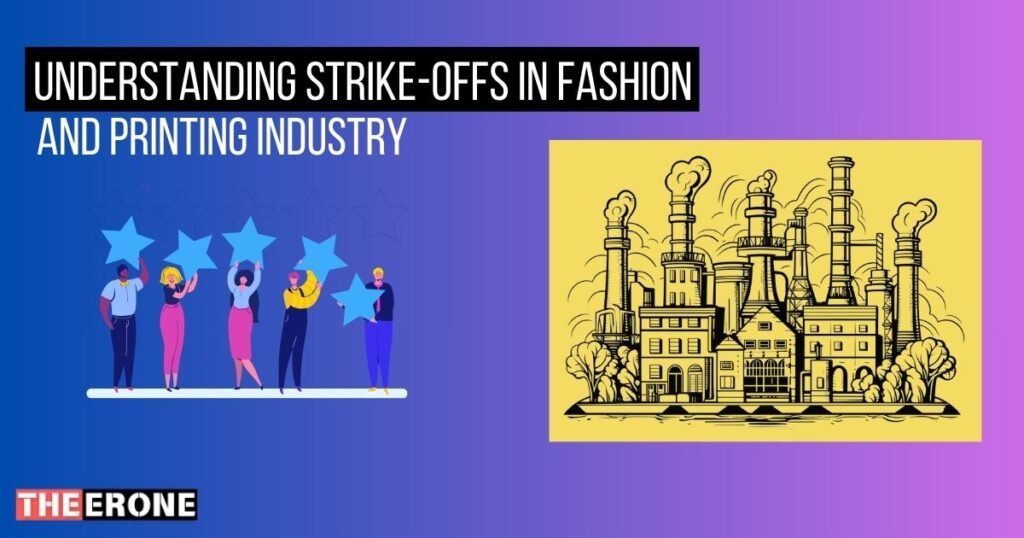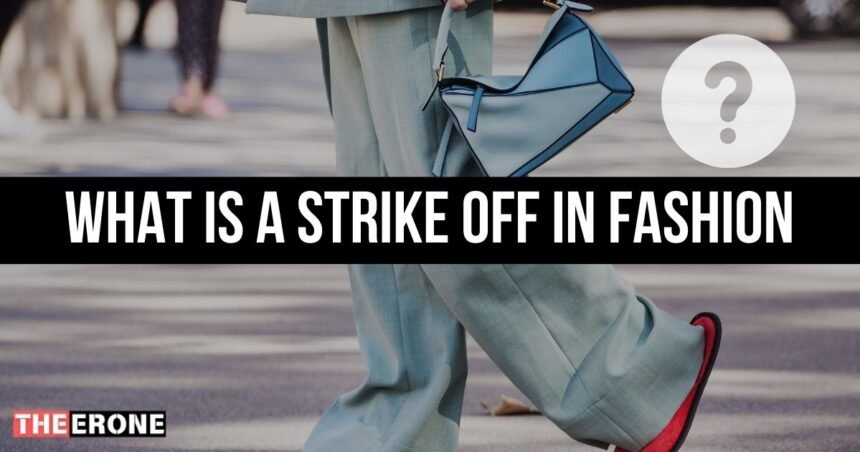A strike-off in fashion is a small fabric sample created to test designs, colors, and patterns before bulk production. It helps ensure the design meets the client’s expectations and maintains high quality. Manufacturers use strike-offs to check color accuracy, fabric compatibility, and overall design appeal.
This process allows designers to make adjustments before moving forward with larger orders. Strike-offs are essential for maintaining precision and avoiding costly mistakes in textile production. They play a key role in quality control and ensuring customer satisfaction. Both designers and manufacturers rely on strike-offs to ensure the final product aligns with the concept.
By reviewing a strike-off, teams can confirm that the colors and patterns look appealing and meet technical requirements. Overall, it is an essential step in the fashion and textile industry’s production process. Knowing about strike-offs helps anyone understand how precision is achieved in clothing design.
Understanding Strike Off in Fashion
Simply put, a strike-off is a sample of fabric or print created to preview and test the design before starting mass production. It is commonly used in the textile and printing industries to validate colors, patterns, and overall design quality. Strike-offs ensure that what’s envisioned on paper is replicated accurately on fabric.
Strike Off Sample Meaning and Its Role in the Textile Industry
Testing how it will look in real Life is essential when creating a new design. A strike-off sample is a small fabric swatch or a piece of material that showcases the design, either as a print or embroidery preview.
It acts as a visual and physical proof to refine details and approve the design before committing to large-scale production.
Why Strike-Offs Are Important
Ensuring Quality Control and Design Accuracy
For textile manufacturers and garment designers, strike-offs are indispensable. They help ensure that the final product matches the vision of the design. By reviewing a strike-off, manufacturers can identify flaws or inconsistencies early, avoiding costly errors later in mass production.
Preventing Errors and Reducing Costs
Spotting issues in the strike-off phase helps save time, materials, and money. Correcting errors during this stage is far cheaper than discovering defects after production has begun. This makes strike-offs an essential step to prevent waste and ensure customer satisfaction.
Understanding Strike-Offs in Fashion and the Printing Industry

Strike-offs aren’t limited to the fashion industry; they also play a critical role in printing. Here’s how they are used in both sectors:
- Fashion Industry: Strike-offs are small sample swatches that test patterns, colors, and textures before finalizing garments and fabric designs. They allow designers to evaluate the fabric’s looks and feels, ensuring that the final product meets the desired quality and aesthetic standards.
- Printing Industry: Strike-offs are test prints created to verify the quality, accuracy, and appearance of printed images or designs on materials like paper, fabric, or plastic. These samples help identify adjustments needed before starting full-scale production, ensuring the final output meets expectations.
Comparison of Strike Off Fabric and Strike Off in Printing
Strike-off fabric typically focuses on design placement, texture, and color consistency for garments. Strike-offs in printing, on the other hand, may involve testing logos, artwork, or other graphics on assorted materials like bags, promotional items, or packaging.
| Aspect | Strike Off Fabric | Strike Off in Printing |
| Definition | A small sample of fabric created to test the look, color, or texture. | A small sample of fabric is created to test the look, color, or texture. |
| Purpose | To check the quality, texture, and color of the fabric. | To ensure the design, colors, and patterns are accurate before production. |
| Process | Fabric is produced in small batches using the planned materials. | A sample is printed on paper or fabric to verify the design’s final look. |
| Focus | Focuses on the material’s feel and quality. | Focuses on the accuracy and placement of the printed design. |
| Usage | Used for garments and other textile products requiring specific fabrics. | Used for printed garments or products like T-shirts, banners, and posters. |
| Who Uses It? | Fashion designers, textile manufacturers, and garment makers. | Graphic designers, print manufacturers, and apparel companies. |
| Key Benefit | Ensures fabric quality and avoids surprises in the final product. | Prevents errors in design and saves costs during mass production. |
Examples of strike-offs in Fashion
Strike-offs are commonplace in various garment designs and fabric printing techniques. Here are some examples:
- All-Over Prints (AOPs): Strike-offs ensure that large repeating prints align seamlessly across a fabric surface.
- Placement Prints: Strike-offs help assess how specific elements like logos or graphics appear on a garment.
- Embroidery Strike-Offs: These test intricate embroidery designs, ensuring precision and proper stitching density.
Types of Strike-Offs in Garment Design
Strike-offs come in various forms based on the needs of the design and production process:
Overview of Strike-Off Variants
- Printed Strike-Offs: Test patterns, colors, and alignment for printed fabrics.
- Embroidery Strike Offs: Focus on validating embroidery designs.
- AOP Shrike Offs: Preview large, repeating prints across a garment.
- Placement Shrike Offs: Review designs for localized areas like logos or decals.
Strike-Offs for AOPs vs. Placement Prints
All-over prints require strike-offs to check pattern flow and ensure alignment on fabric edges. Placement print strike-offs specifically test smaller, targeted areas like chest logos.
| Feature | All-Over Prints (AOPs) | Placement Prints |
| Definition | A design that covers the entire surface of the fabric, repeating seamlessly. | A specific design printed on a particular area of the fabric or garment. |
| Examples | Floral patterns, geometric designs, or abstract prints on an entire fabric. | Logos, slogans, or graphics on the chest, sleeve, or back of a garment. |
| Purpose | Used to create a continuous, uniform pattern for garments or textiles. | Highlights a single focal design element for branding or aesthetics. |
| Process | Requires a full fabric layout to test the print’s repetition and alignment. | Tests how the design fits and looks on a specific area of the garment. |
| Approval Time | Can take longer due to the complexity of ensuring seamless repeats. | Usually quicker since the focus is on one section of the garment. |
| Common Uses | Dresses, shirts, curtains, and upholstery with full patterns. | T-shirts, hoodies, and caps with logos or images. |
| Strike-Off Needs | Requires larger samples to evaluate the full design and color accuracy. | Smaller samples are often enough to assess the placement and size. |
Process of Creating a Strike-Off in Fashion
Creating a strike-off involves several steps to ensure it accurately represents the intended design.
Step-by-Step Explanation
- Design Preparation: The designer or client provides the fabric or print design specifications.
- Material Selection: The appropriate fabric or material is chosen for the strike-off.
- Sample Production: The design is applied to a small piece of fabric using the intended production method.
- Evaluation: The strike-off is inspected for flaws, color accuracy, or design inconsistencies.
- Approval/Revision: If approved, production moves forward. If not, revisions are made, and a new strike-off may be created.
Strike Off Approval Process
For a strike-off to be approved, it must meet several quality criteria, including:
- Matching colors accurately to the design specifications.
- Even design alignment and placement.
- Correct texture and fabric compatibility.
- No visible flaws or defects.
Importance of Strike-Offs in Garment Production
Strike-offs serve as a critical checkpoint during the production phase. Here’s why they matter:
Role in Ensuring Quality Control
Strike-offs ensure that any issues in the design are addressed before large-scale production begins. This minimizes risks and maximizes efficiency in delivering high-quality garments.
Printing Techniques for Strike-Offs
Different printing methods, such as screen printing, digital printing, and sublimation, may be used depending on the project. Strike-offs allow manufacturers to test these techniques and determine the most suitable option for the final product.
What is Lab Dip in the Garment Industry?
A lab dip in the garment industry is a small fabric sample dyed to match a specific color. It helps ensure the color meets the designer’s or customer’s expectations before large-scale production. Manufacturers use lab dips to avoid color mismatches, which can save time and reduce costly mistakes.
It is a vital step in maintaining quality and consistency in clothing production. The process involves testing different dye formulations to achieve the desired shade accurately. Lab dips are approved, ensuring the selected color meets the customer’s requirements. This protects brand reputation and assures customer satisfaction through precise color matching.
Both textile manufacturers and designers rely on lab dips for smoother production workflows. Reviewing and approving lab dips helps reduce errors and unnecessary waste. Ultimately, lab dips play a key role in creating garments with visual appeal and market success.
Lab Dips vs. Strike Offs
It’s common for people to confuse lab dips with strike-offs, but they serve different purposes.
Here’s an easy-to-read table explaining the differences between lab dips and strike-offs:
| Feature | Lab Dips | Strike Offs |
| Definition | Small fabric samples dyed to match a specific color. | Small fabric samples are printed to test a design or pattern. |
| Purpose | Ensures the correct color is achieved before mass production. | Ensures the design or pattern looks right on the fabric. |
| Used For | Checking and approving colors for solid-colored fabrics. | Checking and approving designs, such as prints or embroidery. |
| Process | Fabric is dyed with test colors and compared to the desired shade. | The design is applied to a small piece of fabric for review. |
| Focus Area | Focuses on color accuracy. | Focuses on design and pattern accuracy. |
| When Used | At the start of production to finalize fabric colors. | Before printing or applying the design to all fabrics. |
| Examples | Matching shades of blue for uniforms or dresses. | Testing floral or geometric prints on T-shirts or dresses. |
| Cost | Generally lower as it involves only color testing. | Slightly higher due to printing or embroidery processes. |
Key Takeaways
- Lab Dips are all about color and are used to ensure that solid-colored fabrics match the designer’s requirements.
- Strike-offs check how a design, like a print or embroidery, will appear on the fabric.
- Both processes are essential to avoid mistakes and ensure high-quality garments.
When to Use Lab Dips vs. Strike-Offs
Lab dips are used for color verification, while strike-offs aim to review the whole design, making them the final step before starting production.
Benefits of Strike-Offs for Textile Manufacturers
Ensuring Accuracy and Reducing Waste
Strike-offs improve accuracy by identifying issues early. This reduces waste by avoiding errors during mass production, ensuring resources are used efficiently.
Enhancing Efficiency in Production
By resolving design problems early, strike-offs streamline the production process and improve turnaround times. This boosts overall efficiency and reduces delays in production schedules.
Conclusion
Strike-offs play a critical role in the fashion and printing industries. They ensure designs are accurate before production, saving time and effort. By catching mistakes early, strike-offs help maintain high-quality standards for finished products. Manufacturers use them to avoid costly production errors and reduce material waste.
This process ensures designs match creative ideas precisely as planned. Strike-offs also improve efficiency, leading to faster production timelines and smoother workflows. Without strike-offs, there would be more risks of errors and extra costs. They give both designers and manufacturers confidence about the final look of their products.
Strike-offs are an innovative tool to create incredible designs while staying cost-effective. Every successful garment or print often starts with a well-done strike-off. It’s the key to turning creative visions into reality with precision and quality.
FAQs
What is the strike-off approval process?
The strike-off approval process ensures designs meet expectations by testing colors, patterns, and quality. Stakeholders review and confirm the sample before starting production, preventing costly mistakes.
What are common challenges in creating a strike-off?
Common challenges include color mismatches, fabric inconsistencies, and lengthy approval timelines, causing delays. Proper communication and attention to detail help minimize these issues for smooth production.
How do strike-offs differ between embroidery and printing?
Strike-offs for embroidery focus on thread quality and detail, while printing emphasizes color accuracy. Each requires unique materials and techniques to achieve precise, high-quality results.












